Themed collection Advanced Nanomaterials for Energy Conversion and Storage

Advanced nanomaterials for energy conversion and storage: current status and future opportunities
Guest Editors Wee-Jun Ong, Nanfeng Zheng and Markus Antonietti introduce the Nanoscale themed collection on advanced nanomaterials for energy conversion and storage.
Nanoscale, 2021,13, 9904-9907
https://doi.org/10.1039/D1NR90103F
Carbon-based materials for photo- and electrocatalytic synthesis of hydrogen peroxide
Advanced carbon-based materials are highlighted for light- and electricity-driven oxygen reduction and water oxidation towards hydrogen peroxide.
Nanoscale, 2020,12, 16008-16027
https://doi.org/10.1039/D0NR03178J
2D molybdenum disulphide nanosheets incorporated with single heteroatoms for the electrochemical hydrogen evolution reaction
2D nanosheets give enhanced surface area to volume ratios in particle morphology and they can also provide defined surface sites to disperse foreign atoms.
Nanoscale, 2020,12, 10447-10455
https://doi.org/10.1039/D0NR01295E
Random alloy and intermetallic nanocatalysts in fuel cell reactions
Engineering the surface/near-surface nanostructure is a promising strategy to improve the electrocatalytic performance of alloys, which can maximize the exposure and utilization of active sites.

Nanoscale, 2020,12, 19557-19581
https://doi.org/10.1039/D0NR05475E
Key issues facing electrospun carbon nanofibers in energy applications: on-going approaches and challenges
Recent advances in the on-going approaches for activating electrospun carbon nanofibers and addressing the key issues faced are critically examined in connection with their electrochemical performance as supercapacitor electrodes.
Nanoscale, 2020,12, 13225-13248
https://doi.org/10.1039/D0NR03425H
Recent advances in engineering active sites for photocatalytic CO2 reduction
This review highlights recent advances in the strategies for engineering active sites on surfaces and in open frameworks toward photocatalytic CO2 reduction.
Nanoscale, 2020,12, 12196-12209
https://doi.org/10.1039/D0NR02596H
In situ unraveling of the effect of the dynamic chemical state on selective CO2 reduction upon zinc electrocatalysts
Unraveling the reaction mechanism behind CO2RR via a series of in situ measurements is a crucial step for advancing the development of efficient and selective catalyst and relations between product selectivity.
Nanoscale, 2020,12, 18013-18021
https://doi.org/10.1039/D0NR03475D
Rational design of MXene@TiO2 nanoarray enabling dual lithium polysulfide chemisorption towards high-performance lithium–sulfur batteries
A novel heterostructure consisting of highly ordered TiO2 nanoarrays grown on the MXene nanosheets displays formidable dual chemisorption capability to trap polysulfides and superior electrochemical performance for Li–S batteries.
Nanoscale, 2020,12, 16678-16684
https://doi.org/10.1039/D0NR03528A
Mesoporous carbon host material for stable lithium metal anode
Lithium metal is promising anode material for next-generation battery system. Here, mesoporous carbon material is applied as a host material and it extends Li metal's cycle life.

Nanoscale, 2020,12, 11818-11824
https://doi.org/10.1039/D0NR02258F
Unveiling the size effect of Pt-on-Au nanostructures on CO and methanol electrooxidation by in situ electrochemical SERS
Size effects of Pt on electrooxidation are revealed by in situ electrochemical SERS using bifunctional Au–Pt core–satellite nanocomposites.
Nanoscale, 2020,12, 5341-5346
https://doi.org/10.1039/C9NR10304J
The role of carbon dots – derived underlayer in hematite photoanodes
We developed a carbon underlayer from low-cost carbon dots between FTO and hematite photoanodes. The bulk and interfacial charge transfer dynamics of hematite are greatly improved, leading to a remarkable enhancement in the photocurrent response.
Nanoscale, 2020,12, 20220-20229
https://doi.org/10.1039/D0NR06139E
W-Doped TiO2 for photothermocatalytic CO2 reduction
TiO2 is one of the most widely used photocatalysts and photothermocatalysts.

Nanoscale, 2020,12, 17245-17252
https://doi.org/10.1039/D0NR03393F
Selective electrochemical reduction of carbon dioxide to ethylene on a copper hydroxide nitrate nanostructure electrode
Enhanced C2H4 selectivity on the defect rich, rough and dendritic surface.
Nanoscale, 2020,12, 17013-17019
https://doi.org/10.1039/D0NR02591G
Exploring the thermoelectric properties of oligo(phenylene-ethynylene) derivatives
Seebeck coefficient measurements provide unique insights into the electronic structure of single-molecule junctions.
Nanoscale, 2020,12, 15150-15156
https://doi.org/10.1039/D0NR03303K
Boosting perovskite nanomorphology and charge transport properties via a functional D–π-A organic layer at the absorber/hole transporter interface
The coating of perovskites with D35 improves the performance of PSCs. D35 plays a versatile functional role.
Nanoscale, 2020,12, 15137-15149
https://doi.org/10.1039/D0NR02562C
A MoS2@SnS heterostructure for sodium-ion storage with enhanced kinetics
A MoS2@SnS heterostructure can serve as an advanced anode for sodium-ion batteries with enhanced reaction kinetics.
Nanoscale, 2020,12, 14689-14698
https://doi.org/10.1039/D0NR02604B
Electroactivation-induced IrNi nanoparticles under different pH conditions for neutral water oxidation
Electrochemical activation with a different pH environment changes the morphology and intrinsic catalytic properties of carbon-supported IrNi nanoparticles for oxygen evolution reaction (OER).
Nanoscale, 2020,12, 14903-14910
https://doi.org/10.1039/D0NR02951C
A facile approach to high-performance trifunctional electrocatalysts by substrate-enhanced electroless deposition of Pt/NiO/Ni on carbon nanotubes
Trifunctional electrocatalysts for the oxygen reduction reaction (ORR), oxygen evolution reaction (OER) and hydrogen evolution reaction (HER) are crucial for many electrochemical devices.
Nanoscale, 2020,12, 14615-14625
https://doi.org/10.1039/D0NR03378B
Tunable electrochromic behavior of titanium-based MXenes
Two-dimensional transition metal carbides, nitrides and carbonitrides, popular by the name MXenes, are an emerging class of materials for tunable plasmonic electrochromic applications.
Nanoscale, 2020,12, 14204-14212
https://doi.org/10.1039/D0NR02673E
Inducing rapid polysulfide transformation through enhanced interfacial electronic interaction for lithium–sulfur batteries
Sluggish dynamics of polysulfide conversion leads to reduced utilization of active sulfur and rapid capacity decay.
Nanoscale, 2020,12, 13980-13986
https://doi.org/10.1039/D0NR02429E
Silicon oxycarbide-antimony nanocomposites for high-performance Li-ion battery anodes
Homogeneously embedded Sb NPs in a SiOC with the size of 5–40 nm were synthesized via the pyrolysis of a preceramic polymer. SiOC/Sb exhibits high rate capability with a charge-storage capacity of 549 mAh g−1 at a current density of 2232 mA g−1.
Nanoscale, 2020,12, 13540-13547
https://doi.org/10.1039/D0NR02930K
Tubular assemblies of N-doped carbon nanotubes loaded with NiFe alloy nanoparticles as efficient bifunctional catalysts for rechargeable zinc-air batteries
Porous tubular carbon assemblies encapsulating NiFe alloys as bifunctional catalysts toward ORR and OER were designed via a sacrificial-template strategy.
Nanoscale, 2020,12, 13129-13136
https://doi.org/10.1039/D0NR02486D
An interlayer composed of a porous carbon sheet embedded with TiO2 nanoparticles for stable and high rate lithium–sulfur batteries
An interlayer favoring Li ion diffusion and polysulfide blocking for Li–S batteries was fabricated by using porous carbon nanosheets embedded with TiO2 nanoparticles.

Nanoscale, 2020,12, 12308-12316
https://doi.org/10.1039/D0NR02607G
Ru and RuOx decorated carbon nitride for efficient ammonia photosynthesis
A ternary heterostructure Ru/RuO2/g-C3N4 was designed for ammonia photosynthesis under visible light irradiation, which exhibited 6 times higher activity with excellent stability than the pristine g-C3N4.
Nanoscale, 2020,12, 12329-12335
https://doi.org/10.1039/D0NR02527E
Hybrid phase 1T/2H-MoS2 with controllable 1T concentration and its promoted hydrogen evolution reaction
1T concentration controllable 1T/2H-MoS2 with enhanced electrochemical hydrogen evolution reaction performance has been synthesized.
Nanoscale, 2020,12, 11908-11915
https://doi.org/10.1039/D0NR02525A
Interstratified heterostructures of metal hydroxide nanoclusters and MoS2 monolayers with improved electrode performance
Interstratified 2D nanohybrids of chromium hydroxide–molybdenum disulfide with improved electrode functionality are synthesized by the self-assembly of anionic monolayered MoS2 nanosheets with cationic chromium hydroxide nanoclusters.
Nanoscale, 2020,12, 11759-11766
https://doi.org/10.1039/D0NR02569K
Ni/Co bimetallic organic framework nanosheet assemblies for high-performance electrochemical energy storage
Multilayer NiCo-MOF nanosheet assemblies hold great potential as an electrode material for EES equipment. A facile one-pot synthesis procedure, high capacity and stable performance are prominent features of multilayer NiCo-MOF materials.
Nanoscale, 2020,12, 10685-10692
https://doi.org/10.1039/D0NR02016H
The synthesis of interface-modulated ultrathin Ni(II) MOF/g-C3N4 heterojunctions as efficient photocatalysts for CO2 reduction
Interface-modulated ultrathin Ni(II) MOF/g-C3N4 heterojunctions exhibit greatly improved charge separation and, consequently, 18-fold photoactivity enhancement for the CO2RR.
Nanoscale, 2020,12, 10010-10018
https://doi.org/10.1039/D0NR02551H
In situ growth of well-aligned Ni-MOF nanosheets on nickel foam for enhanced photocatalytic degradation of typical volatile organic compounds
Well-aligned Ni-MOF nanosheet arrays vertically grown on nickel foam were synthesized via a facile in situ solvothermal strategy, which exhibited remarkably improved photocatalytic activities to typical VOCs under visible light irradiation.
Nanoscale, 2020,12, 9462-9470
https://doi.org/10.1039/D0NR01027H
Three-dimensional graphene-supported nickel disulfide nanoparticles promise stable and fast potassium storage
A self-adaptive NiS2/3DGO electrode was designed and the conversion reaction mechanism during potassium storage processes was clearly revealed.

Nanoscale, 2020,12, 8255-8261
https://doi.org/10.1039/D0NR01274B
Nanostructured potassium–organic framework as an effective anode for potassium-ion batteries with a long cycle life
Novel nanostructured non-redox-metal potassium metal–organic framework, [C7H3KNO4]n, as an effective organic anode for long-cycle life OPIBs.
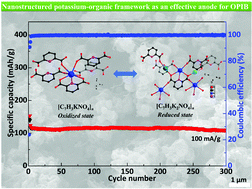
Nanoscale, 2020,12, 7870-7874
https://doi.org/10.1039/D0NR00964D
Photocatalytic CO2 reduction of C/ZnO nanofibers enhanced by an Ni-NiS cocatalyst
Photocatalyst Ni-NiS/C/ZnO shows improved photocatalytic CO2-reduction activity due to enhanced light absorption, good CO2 adsorption and effective charge separation.
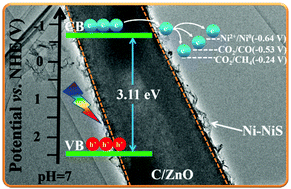
Nanoscale, 2020,12, 7206-7213
https://doi.org/10.1039/C9NR10451H
Embedded carbon in a carbon nitride hollow sphere for enhanced charge separation and photocatalytic water splitting
Graphitic carbon was fully embedded inside the graphitic carbon nitride hollow sphere via the modified shape-selective templating method in order to enchance visible light absorption and promote charge seperation.

Nanoscale, 2020,12, 7339-7346
https://doi.org/10.1039/D0NR00226G